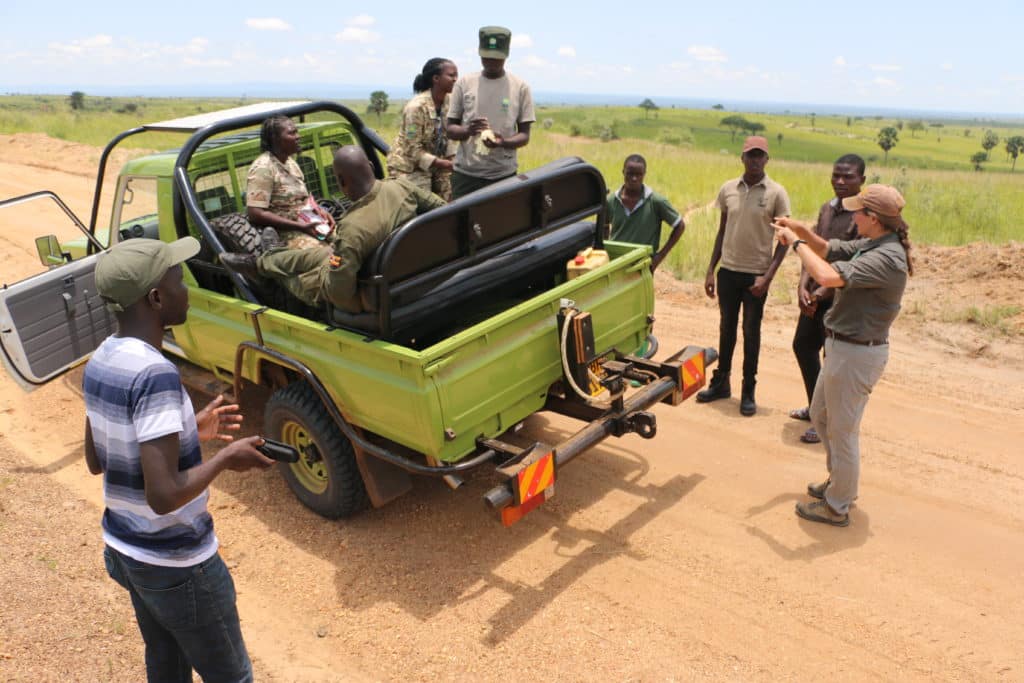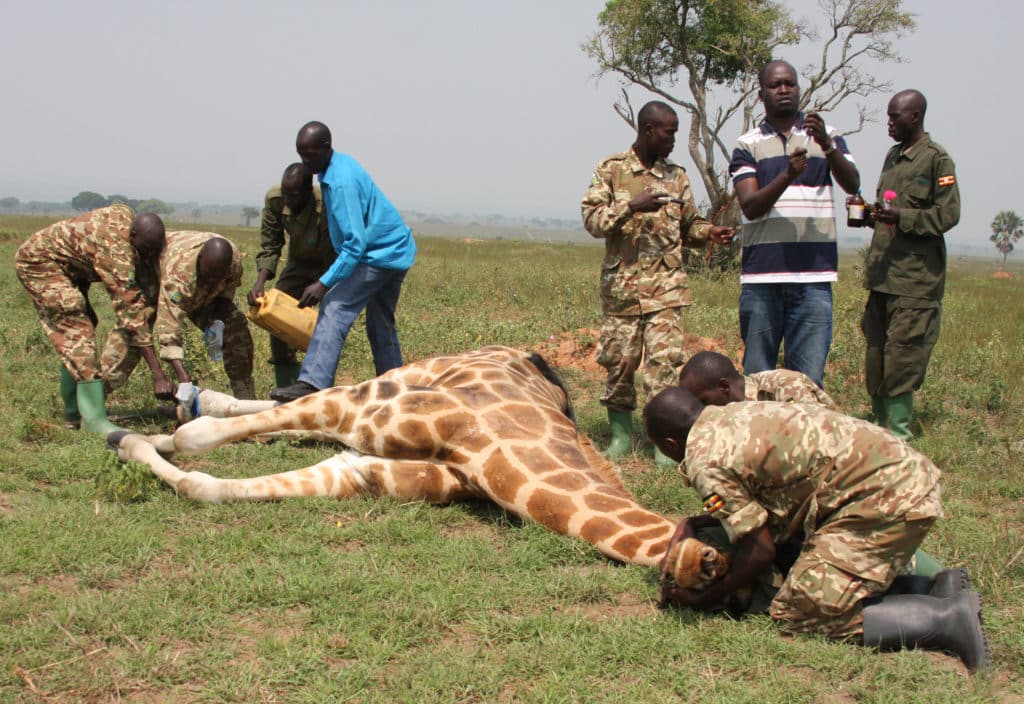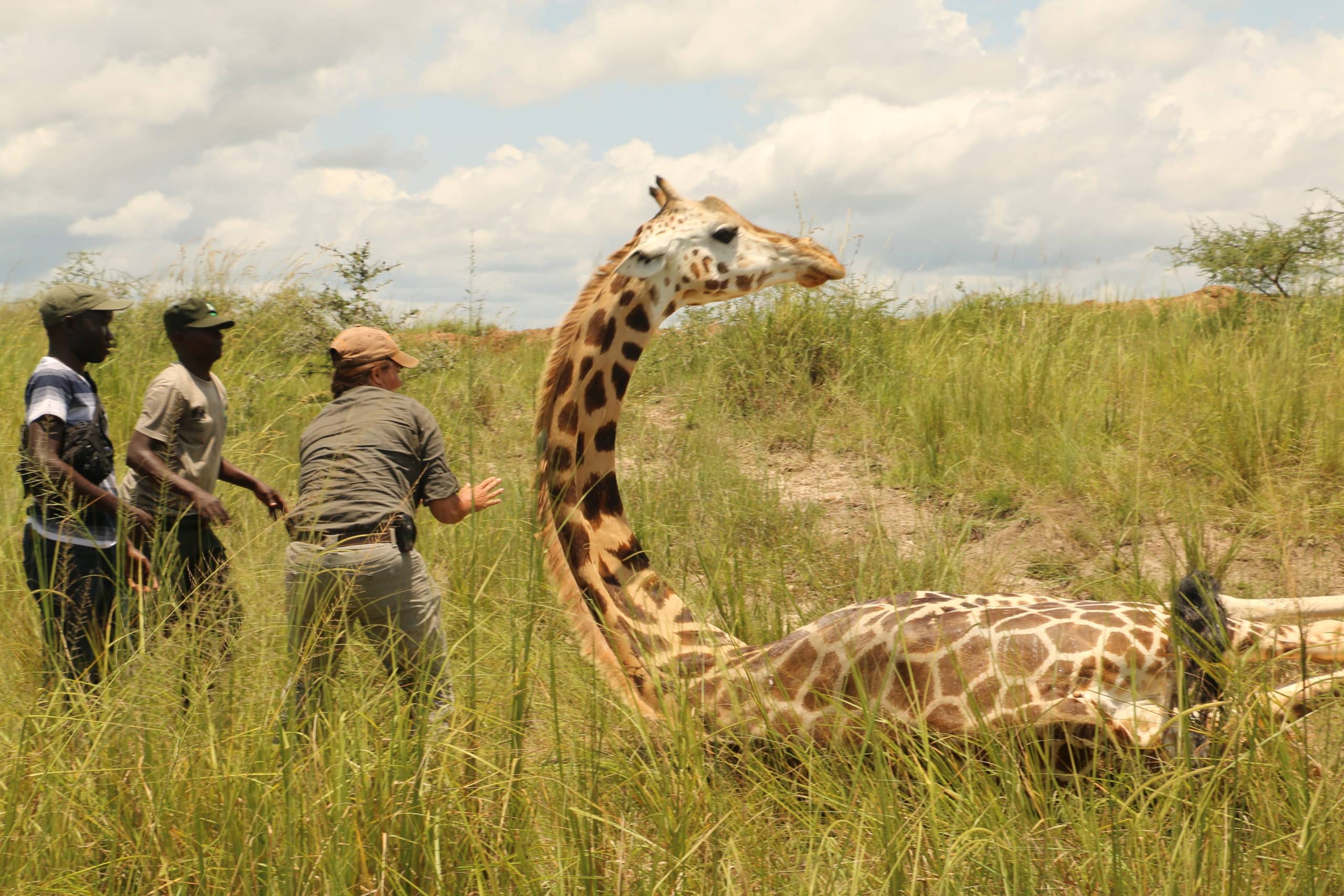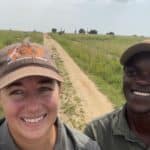“There are birds!” Dr. Joshua Lubega, a recently graduated Ugandan wildlife veterinarian, sighs to me, looking through the scope of the CO2 powered dart gun.
“Well,” I reply, “What do you think? It doesn’t look like he will allow us any closer, and besides, you have totally got this.”
Dr. Lubega looks back through the scope and I hear the ‘click’ as he removes the safety, followed by the hiss of released air and – a moment later – the satisfying ‘thwack’ of the medicine laden dart hitting the shoulder of a Critically Endangered adult male Nubian giraffe.
We turn to look at the clock on the dashboard of the Landcruiser, brushing away the ever-present layer of dust, and note the time, knowing we have about 3 minutes before we will see if the dart has hit the bull successfully and the drug is going to work. I turn to Dr. Lubega. “Great shot, Doctor. That was perfectly placed, and you didn’t accidentally hit one of the birds!”

GCF team Uganda – Murchison Falls NP © GCF (Sara Ferguson)
It is one of those days where the heat is far beyond unbearable. The sun is relentless with no cloud in the sky, the air is oppressively still, and the ever-present humidity makes you feel like you are breathing through one of those hot wet towels they give you at a sauna. Today, we are a team of seven: Dr. Joshua Lubega and myself, Dr. Sara Ferguson, both from the Giraffe Conservation Foundation and five rangers from the dedicated Veterinary Response team of the Uganda Wildlife Authority (UWA). We have been patrolling for four hours around the iconic Murchison Falls National Park, situated in northwest Uganda and bisected by the famous Nile River. The giraffe we have just darted is a large bull sporting an illegal wire snare on his left hind limb. Illegal hunting (poaching) for bushmeat is a huge problem in Murchison Falls NP. Poachers looking to catch smaller antelope species hang wire nooses over animal trails, hoping to catch something around the neck. However, giraffes often walk through these traps and are strong enough to break the wire from where it is anchored and end up trailing the wires caught around their legs – often dragging along a bush or tree. If left unattended these wire snares can cause significant injury or even death.

Truck with snares © GCF (Sara Ferguson)
That’s where we come in: the joined UWA/GCF mobile veterinary team sets out to find giraffes (and all other wildlife) that have become entangled in these illegal snare traps and immediately rescue these animals, providing life-saving treatments as needed.
It has been four minutes since our male giraffe has been darted, and he is displaying the typical drunken gait that shows us that the drug (a highly potent opioid similar to morphine) has taken effect. The team collectively braces for the oncoming whirlwind of activity. Due to their unique anatomy, giraffe are tricky animals to safely treat and require an experienced team. In the next few minutes, the giraffe will need to be roped down and the UWA/GCF vet team, today led by Dr. Lubega, will administer the antidote to the drug, remove the wire from the hind limb, clean the small cut caused by the wire (this giraffe was very lucky!), and administer a shot of antibiotics before getting the giraffe back onto his feet, all before he has really appreciated what has happened to him.

Nubian giraffe being capture to remove wire snare on foot in Murchison Falls NP, Uganda © GCF (Michael Brown)
Dr. Lubega graduated from the University of Makerere’s College of Veterinary Medicine and joined the UWA/GCF mobile vet team to gain more experience in wildlife veterinary medicine as well as giraffe conservation. He is passionate about providing the best possible veterinary care to wildlife and is doing an exceptional job in the field. The giraffe successfully treated today is just one of over 20 Dr. Lubega has rescued in the past month alone. This particular male giraffe tested Dr. Lubega’s darting skills as he was surrounded by a flock of yellow-billed oxpeckers right where the dart needed to go. However, as is the case with all wildlife, sometimes you only get one shot, and you need to take it, or you may miss your opportunity to rescue the animal!

Nubian giraffe having wire snare removed from foot in Murchison Falls NP, Uganda © GCF (Michael Brown)
Since joining forces in 2019, the UWA/GCF mobile veterinary team has already rescued over 400 animals from wire snares – over 250 of these rescues have been Critically Endangered Nubian giraffes. With a giraffe population of approximately 1,800, Murchison Falls NP is home to the world’s largest wild population of Nubian giraffes. There are only about 3,000 remaining in the wild throughout East Africa.
GCF is proud to be a voice for giraffes and to partner with UWA on this incredible conservation success story.


